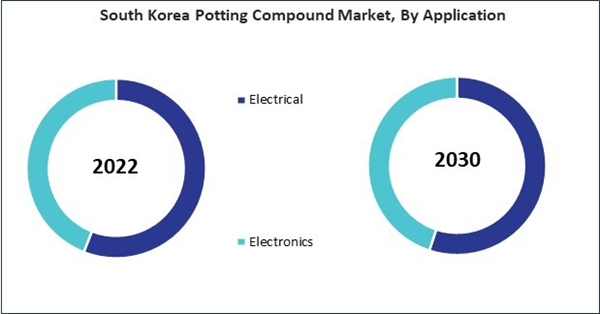Potting compounds utilizing UV curing technology are gaining traction across various industries for encapsulating and protecting electronic components due to their rapid curing and superior performance properties. Thus, the South Korea market consumed 37.58 kilo tonnes of potting compounds in the market 2022.
The China market dominated the Asia Pacific Potting Compound Market by Country in 2022, and would continue to be a dominant market till 2030; thereby, achieving a market value of $572.3 million by 2030. The Japan market is showcasing a CAGR of 4.6% during (2023 - 2030). Additionally, The India market would register a CAGR of 3.9% during (2023 - 2030).
It provides a reliable solution for encapsulating these components, ensuring their longevity and reliability in harsh operating conditions. A higher risk of component damage results from the diminished physical space available for protection as electronic devices become more diminutive and compact.
Moreover, It is effectively encapsulate miniaturized components, safeguarding them from external hazards without compromising performance or reliability. Manufacturers are becoming more aware of the reliability issues associated with unprotected electronic components, including premature failure, decreased performance, and costly repairs or replacements.
According to the India Brand Equity Foundation, India is one of the greatest consumer electronics sectors in the Asia-Pacific region. It is home to a substantial talent for electronic and embedded software design. India has committed to attain US$ 300 billion in electronics manufacturing and US$ 120 billion in exports by 2025-26. Therefore, due to the above-mentioned factors, the potting compound market will grow significantly in this region.
Based on Application, the market is segmented into Electrical, and Electronics. Based on Curing Technology, the market is segmented into UV Curing, Thermal Curing, and Room Temperature Curing. Based on End User, the market is segmented into Electronics, Aerospace, Automotive, Industrial, and Others. Based on Resin Type, the market is segmented into Silicone, Epoxy, Polyurethane, Polyester, Polyamide, Polyolefin, and Acrylics. Based on countries, the market is segmented into China, Japan, India, South Korea, Singapore, Malaysia, and Rest of Asia Pacific.
List of Key Companies Profiled
- The Dow Chemical Company
- Dymax Corporation
- Henkel AG & Company, KGaA
- Huntsman Corporation
- MG Chemicals
- Wacker Chemie AG
- 3M Company
- WEVO-CHEMIE GmbH
- Shanghai SEPNA Chemical Technology Co., Ltd.
- Master Bond Inc.
Market Report Segmentation
By Application (Volume, Kilo Tonnes, USD Billion, 2019-2030)- Electrical
- Electronics
- UV Curing
- Thermal Curing
- Room Temperature Curing
- Electronics
- Aerospace
- Automotive
- Industrial
- Others
- Silicone
- Epoxy
- Polyurethane
- Polyester
- Polyamide
- Polyolefin
- Acrylics
- China
- Japan
- India
- South Korea
- Singapore
- Malaysia
- Rest of Asia Pacific
Table of Contents
Companies Mentioned
- The Dow Chemical Company
- Dymax Corporation
- Henkel AG & Company, KGaA
- Huntsman Corporation
- MG Chemicals
- Wacker Chemie AG
- 3M Company
- WEVO-CHEMIE GmbH
- Shanghai SEPNA Chemical Technology Co., Ltd.
- Master Bond Inc.
Methodology

LOADING...








